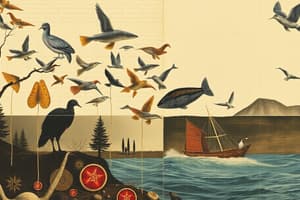Podcast
Questions and Answers
What is the primary role of producers in a food chain?
What is the primary role of producers in a food chain?
- To increase the predator population
- To reduce the energy levels in the ecosystem
- To consume other organisms for energy
- To convert inorganic resources into food (correct)
How does the predator-prey relationship influence population dynamics?
How does the predator-prey relationship influence population dynamics?
- An increase in predator numbers always leads to a decline in prey.
- Prey populations can increase if predator numbers decrease. (correct)
- Predators rely solely on the availability of plants.
- A decline in prey leads to an increase in predator birth rates.
What percentage of energy captured by producers typically transfers to the next trophic level?
What percentage of energy captured by producers typically transfers to the next trophic level?
- 25%
- 50%
- 1%
- 10% (correct)
Which of the following statements about consumers is true?
Which of the following statements about consumers is true?
What is a characteristic feature of a food web compared to a food chain?
What is a characteristic feature of a food web compared to a food chain?
What happens to energy as it moves up trophic levels in a food chain?
What happens to energy as it moves up trophic levels in a food chain?
Which organisms are classified as herbivores?
Which organisms are classified as herbivores?
In a predator-prey dynamic, what is likely to happen when prey populations increase significantly?
In a predator-prey dynamic, what is likely to happen when prey populations increase significantly?
Flashcards
Herbivore
Herbivore
An organism that only eats plants.
Carnivore
Carnivore
An organism that only eats meat.
Omnivore
Omnivore
An organism that eats both plants and meat.
Predator
Predator
Signup and view all the flashcards
Prey
Prey
Signup and view all the flashcards
Producer
Producer
Signup and view all the flashcards
Trophic Level
Trophic Level
Signup and view all the flashcards
Energy Transfer
Energy Transfer
Signup and view all the flashcards
Study Notes
Food Chains and Relationships
- Species can be herbivores (plant-eaters), carnivores (meat-eaters), or omnivores (eating both plants and meat).
- Herbivores don't need to hunt, as plants are readily available and replenish quickly.
- Carnivores are predators that need to hunt to get food.
- Predators and prey populations have a cyclical relationship; when prey numbers are low, predators struggle and prey numbers rise; when prey numbers are high, predators thrive and prey numbers drop.
Trophic Levels
- The bottom of a food chain is the producer (e.g., plants, some bacteria).
- Producers make their own food using energy.
- Consumers are heterotrophs, meaning they must eat other organisms for energy.
- Primary consumers are the first consumers.
- Consumers at different levels in a food chain are called trophic levels.
- Each trophic level above the previous one loses roughly 90% of its energy, so longer food chains have less energy available to the top predators.
Studying That Suits You
Use AI to generate personalized quizzes and flashcards to suit your learning preferences.




